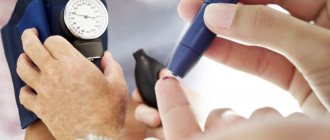Treatment of arterial hypertension in patients with type 2 diabetes mellitus in outpatient settings
Particular attention in the practical activities of a general practitioner and cardiologist is directed to the group of patients with arterial hypertension (AH) and non-insulin-dependent diabetes mellitus.
The combination of diabetes mellitus and hypertension increases the risk of developing coronary artery disease, heart failure, cerebral complications and peripheral vascular diseases. The presence of hypertension accelerates the progression of microvascular complications of diabetes mellitus. These patients have an increased risk of mortality and reduced life expectancy.
Arterial hypertension in patients with diabetes mellitus has specific clinical course. Most of these patients do not have a physiological decrease in blood pressure at night, which causes an increased risk of fatal cardiovascular complications.
The primary and pathogenetically substantiated goal of treating this category of patients is measures aimed at reducing body weight and normalizing metabolic disorders. For such patients, we recommend a hypocaloric diet with reduced fat and limitation of easily digestible carbohydrates. In addition, the diet should be lipid-lowering. Without diet therapy, any treatment is doomed to failure. With a decrease in body weight, a significant improvement in glucose and lipid levels is achieved. We recommend increasing physical activity for all patients with lipid metabolism disorders, because this improves glucose tolerance, reduces insulin concentrations and improves lipid profile.
Undoubtedly, it is very important to achieve maximum compensation for diabetes mellitus with glucose-lowering drugs.
The goal of drug antihypertensive therapy for type 2 diabetes is to reduce the risk of acute and long-term cardiovascular and renal complications and mortality. In this regard, we recommend to reduce the progression of nephropathy to achieve a blood pressure level no higher than 140/85 mm Hg. pillar ACE inhibitors are the first choice antihypertensive drugs, since their organoprotective and metabolically neutral effects have been convincingly demonstrated in a number of large studies.
Over the past three years, according to our data, patients receiving ACE inhibitors were significantly less likely to be hospitalized for unstable angina, myocardial infarction, and stroke.
The second place after ACEIs is occupied by calcium antagonists (CA) of prolonged action, since they do not have an adverse effect on carbohydrate and lipid metabolism. Preference is given to the AK groups of verapamil and diltiazem, because they have a great cardio and renoprotective effect.
The use of thiazide and loop diuretics is undesirable due to their diabetogenic effect. In recent years, new thiazide-like drugs have been created, such as indapamide, arifon, which in an average therapeutic dose act as an antihypertensive drug due to the vasodilator effect and do not have a diuretic effect. Indapamide during long-term therapy does not affect carbohydrate and lipid metabolism and does not worsen renal function.
In our department, patients with type 2 diabetes make up the largest group of dispensary patients - 194 people, of which 79 people have arterial hypertension. As a rule, most of these patients have a disorder of fat metabolism.
41 people — receive antihypertensive therapy with ACE inhibitors: enalapril, re-nitek, Enap, monopril.
17 people take AK, 8 people take diuretics: arifon, indapamide. 13 people receive combination therapy of ACE inhibitors + diuretics. The hospitalization rate and the incidence of myocardial infarction among this category of patients have been decreasing annually since 1999, respectively: 49 people. in 1999; 38 people in 2000 and 24 people. in 2001. Incidence of MI: in 1999 - 6 people; in 2000 - 4 people; in 2001 - 3 people.
Thus, for the successful treatment of arterial hypertension in patients with type 2 diabetes mellitus, along with the use of non-drug and medicinal methods of treating diabetes mellitus, a careful selection of antihypertensive drugs is necessary, taking into account their effect on carbohydrate and lipid metabolism and their organoprotective effect.
L.O. Minushkina
Federal State Budgetary Institution "Educational and Scientific Medical Center" of the Administration of the President of the Russian Federation, Moscow
The article discusses the role of sympathetic activation and features of the treatment of arterial hypertension (AH) in patients with diabetes mellitus (DM). The pharmacological features of amlodipine and bisoprolol are presented, emphasizing the effectiveness of using a combination of these drugs in the treatment of patients with hypertension and diabetes. Keywords:
arterial hypertension, diabetes mellitus, amlodipine, bisoprolol, fixed combination.
About the author:
Minushkina Larisa Olegovna – Doctor of Medical Sciences, Professor of the Department of Therapy, Cardiology and Functional Diagnostics of the Federal State Budgetary Institution "Universal Scientific Medical Center" of the Department of the President of the Russian Federation
Examples of manifestations of arterial atherosclerosis:
- If you have coronary heart disease, you may experience chest pain, a feeling of heaviness or tightness in the chest when climbing stairs, walking, or other activity. Often chest pain radiates to the arm or jaw. Such phenomena are associated with a narrowing of the blood vessels of the heart.
- The classic picture of the development of myocardial infarction: chest pain does not go away, shortness of breath and a feeling of nausea appear, and vomiting begins. The person suddenly breaks out in a cold sweat and experiences a strong feeling of fear. Patients with diabetes may not notice chest pain due to damage to the nervous system and loss of pain sensitivity, then the equivalent of pain is severe general weakness.
- Arterial hypertension (increased blood pressure) is often a companion to diabetes mellitus. It is against the background of high blood pressure that such a formidable complication as a stroke (acute cerebrovascular accident) can develop, which is often fatal or leads to paralysis. Arterial hypertension also has a bad effect on the condition of the blood vessels of the kidneys and fundus.
- Atherosclerotic changes can also develop in the vessels of the brain - cerebral vascular atherosclerosis. In severe cases, this can lead to stroke.
- Problems with the blood vessels of the legs, pain in the calves or buttocks when walking are signs of atherosclerosis of the blood vessels of the legs. Sometimes discomfort occurs during long walking, sometimes after just a few steps. The pain goes away on its own if you stop for a while. With pronounced narrowing of the arteries in the leg area, pain can also occur at rest.
Literature
1. Thorin E., Thorin-Trescases N. Vascular endothelial aging, heartbeat after heartbeat. Cardiovasc Res. 2009 Oct 1; 84(1):24–32. 2. Makrilakis K., Bakris G. Diabetic hypertensive patients: improving their prognosis. J Cardiovasc Pharmacol. 1998; 31: Suppl. 2: S34–S40. 3. Izzo R., de Simone G., Trimarco V. at al. Hypertensive target organ damage predicts incident diabetes mellitus. Eur Heart J. epub 27 June 2013. 4. Ferrannini E. Insulin resistance versus insulin deficiency in non-insulin-dependent diabetes mellitus: problems and prospects. Endocr Rev. 1998; 19: 477–490. 5. Balletshofer BM, Rittig K., Enderle MD, Volk A., Maerker E., Jacob S., Matthaei S., Rett K., Haring HU Endothelial dysfunction is detectable in young normotensive first degree relatives of subjects with type 2 diabetes in association with insulin resistance. Circulation. 2000; 101:1780–1784. 6. Mancia G., Fagard R., Narkiewicz K. et al. 2013 Practice guidelines for the management of arterial hypertension of the European Society of Hypertension (ESH) and the European Society of Cardiology (ESC): ESH/ESC Task Force for the Management of Arterial Hypertension. J Hypertens. Oct 2013; 31(10): 1925–1938. 7. Hansson L., Zanchetti A., Carruthers SG et al. Effects of intensive blood-pressure lowering and low-dose aspirin in patients with hypertension: principal results of the Hypertension Optimal Treatment (HOT) randomized trial. HOT Study Group. Lancet. 1998 Jun 13; 351(9118):1755–1762. 8. Gradman AH, Parisé H., Lefebvre P. et al. Initial combination therapy reduces the risk of cardiovascular events in hypertensive patients: a matched cohort study. Hypertension. Feb 2013; 61(2):309–318. 9. Egan BM, Bandyopadhyay D, Shaftman SR et al. Initial monotherapy and combination therapy and hypertension control the first year. Hypertension. 2012 Jun; 59(6):1124–1131. 10. Cooper-DeHoff RM, Bird ST, Nichols GA et al. Antihypertensive drug class interactions and risk for incident diabetes: a nested case-control study. J Am Heart Assoc. 2013 Jun 10; 2 (3): e000125. 11. Borchard U. Pharmacokinetics of beta-adrenoceptor blocking agents: clinical significance of hepatic and/or renal clearance. Clin Physiol Biochem. 1990; 8 Suppl 2: 28–34. 12. Haasis R., Bethge H.. Exercise blood pressure and heart rate reduction 24 and 3 hours after drug intake in hypertensive patients following 4 weeks of treatment with bisoprolol and metoprolol: a randomized multicentre double-blind study (BISOMET). Eur Heart J. 1987 Dec; 8 Suppl M: 103–113. 13. Fogari R., Zoppi A., Pasotti C. et al. Effects of different beta-blockers on lipid metabolism in chronic therapy of hypertension. Int J Clin Pharmacol Ther Toxicol. 1988 Dec; 26 (12): 597–604. 14. Parrinello G., Paterna S., Torres D. et al. One-year renal and cardiac effects of bisoprolol versus losartan in recently diagnosed hypertensive patients: a randomized, double-blind study. Clin Drug Investig. 2009; 29(9):591–600. 15. Paterna S., Parrinello G., Di Pasquale P. et al. Medium-term effects of bisoprolol administration on renal hemodynamics and function in mild to moderate essential hypertension. Adv Ther. 2007 Nov–Dec; 24 (6): 1260–1270. 16. Zhou WJ, Wang RY, Li Y. et al. A randomized controlled study on the effects of bisoprolol and atenolol on sympathetic nervous activity and central aortic pressure in patients with essential hypertension. PLoS One. 2013 Sep 10; 8(9):e72102. 17. Haneda T., Ido A., Fujikane T. et al. Effect of bisoprolol, a beta 1-selective beta-blocker, on lipid and glucose metabolism and quality of life in elderly patients with essential hypertension Nippon Ronen Igakkai Zasshi. 1998 Jan; 35 (1): 33–38. 18. Wai B., Kearney LG, Hare DL Beta blocker use in subjects with type 2 diabetes mellitus and systolic heart failure does not worsen glycemic control. Cardiovasc Diabetol. 2012 Feb 14; 11: 14. 19. Wang B., Song WH, Liu GZ; Multi-center Cooperation Group of Bisoprolol. The effect long-term administration of a selective beta1 blocker bisoprolol on glucose metabolism in patients with essential hypertensive and type 2 diabetes mellitus Zhonghua Nei Ke Za Zhi. July 2005; 44 (7): 503–5. 20. Janka HU, Ziegler AG, Disselhoff G., Mehnert H. Influence of bisoprolol on blood glucose, glucosuria, and haemoglobin A1 in noninsulin-dependent diabetics. J Cardiovasc Pharmacol. 1986; 8 Suppl 11:S96–99. 21. Zamorano J., Rodriguez Padial L., Cosin J. et al. Amlodipine reduces predicted risk of coronary heart disease in high-risk patients with hypertension in Spain (The CORONARIA Study). J Int Med Res. 2008 Nov–Dec; 36(6):1399–1417. 22. Levine CB, Fahrbach KR, Frame D. et al. Effect of amlodipine on systolic blood pressure. Clin Ther. 2003 Jan; 25 (1): 35–57. 23. Kloner RA, Neutel J, Roth EM et al. Blood pressure control with amlodipine add-on therapy in patients with hypertension and diabetes: results of the Amlodipine Diabetic Hypertension Efficacy Response Evaluation Trial. Ann Pharmacother. 2008 Nov; 42(11):1552–1562. 24. Ersoy C., Imamoğlu S., Budak F. et al. Effect of amlodipine on insulin resistance & tumor necrosis factor-alpha levels in hypertensive obese type 2 diabetic patients. Indian J Med Res. 2004 Nov; 120(5):481–488. 25. Zanetti-Elshater F., Pingitore R., Beretta-Piccoli C. et al. Calcium antagonists for treatment of diabetes-associated hypertension. Metabolic and renal effects of amlodipine. Am J Hypertens. 1994 Jan; 7 (1): 36–45. 26. Shirure PA, Tadvi NA, Bajait CS et al. Comparative effect of fixed dose combination of Amlodipine + Bisoprolol versus Amlodipine and Bisoprolol alone on blood pressure in stage-2 essential hypertensive patients. Int J Med Res Health Sci. 2012; 1 (1): 13–19. 27. Rana R., Patil A. Efficacy and safety of bisoprolol plus amlodipine fixed dose combination in essential hypertension. Indian Pract. 2008; 61:225–234.







